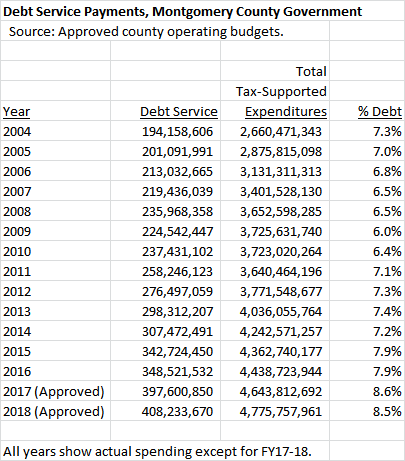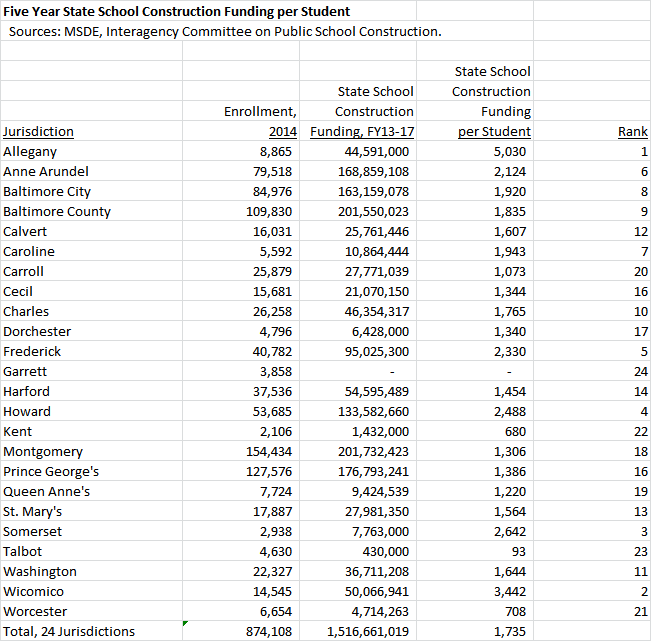By Glenn Orlin.
In a recent piece in Seventh State it was argued that so-called “placeholder” projects have no place in the Montgomery County Public Schools capital program. But there are very good reasons why the County Council has done exactly that for the past eight years.
First, some background. The Subdivision Staging Policy (SSP) Public School Adequacy Test compares enrollment five years in advance—at each cluster and level (HS, MS, or ES), and at each school—against the budgeted capacity at each cluster/level and school five school years hence. If the future enrollment exceeds the future capacity in a cluster by more than 20% at any level, then the cluster goes into a housing moratorium; that is, no more housing subdivisions can be approved until the capacity standard is met. (Relocatable classrooms are not counted towards “capacity” under the School Adequacy Test.) If the future enrollment exceeds the future capacity in a MS service area by more than 20% and 180 students, then that MS service area goes into a housing moratorium. If the future enrollment exceeds the future capacity in an ES service area by more than 20% and 110 students, then that ES service area goes into a housing moratorium. The five-year rule was selected many years ago because, on average, that is how long it takes for a housing subdivision approval to morph into occupied housing units, many of them having kids of school age.
At the start of this decade the Council began the practice of budgeting generic “Solution” (i.e., placeholder) CIP projects in certain circumstances. The rationale is that while a cluster or school service area might have enrollment that exceeds the moratorium threshold, in many cases MCPS is concurrently planning for a new school or addition that would provide sufficient capacity in time to avoid such a moratorium. The Council has approved Solution projects only when all the following conditions are met:
- A cluster or school service area is projected to exceed the moratorium threshold;
- MCPS is concurrently—or about to start—planning for a capital project that would address the potential moratorium; and
- MCPS’s normal schedule for planning, design, and construction would have the project’s added capacity opening by the start of the school year five years hence.
The most recent application of the School Test was approved by the Planning Board on June 22, 2017. The Board placed seven ES service areas into moratorium: Burnt Mills, Highland View, Kemp Mill, Lake Seneca, Rosemont, Strawberry Knoll, and Summit Hall. At that time, while all of them met Condition #1, none of them met Conditions #2 and #3. Eight other clusters or school service areas were not placed into moratorium because Solution projects were justifiable and programmed: they met all three conditions. In the FY19-24 CIP several of these Solution projects will be replaced by specific projects that the Board of Education (BOE) is now officially ready to recommend. This new CIP will include only four Solution projects.
It is important to note that the decision to budget a Solution project for a school has nothing to do with whether there are new housing applications in that area awaiting the Planning Board’s approval. Condition #1 occurs either when projected enrollment growth due to turnover, already approved new housing, or both, will be over the capacity threshold. Whether there are impending housing development applications simply doesn’t matter in the decision to budget a Solution project or not. Now let’s turn to the examples raised in the earlier Seventh State piece.
Bethesda ES and Somerset ES. The service areas for both schools in the B-CC Cluster are projected to be well over capacity (+25% and +27%, respectively) in five years, that is, by the start of the 2023-24 school year. MCPS is initiating an elementary school capacity study for the B-CC Cluster, which would examine a range of options. The study will be conducted during the 2018-2019 school year. The Board of Education (BOE) will then be in position to propose a specific project in its FY21-26 CIP request; if that project’s funding were to begin in FY21, then, following the normal schedule for planning, design, and construction it could open at the start of the 2023-24 school year. Because all three conditions are met—a projected moratorium, planning about to begin, and a path to project completion in five years—the Council is poised to fund Solution projects for Bethesda ES and Somerset ES. The total amount to be budgeted for these two Solution projects is about $6.4 million. When a specific project is ready to be budgeted, this $6.4 million will be used to help fund it.
Judith A. Resnik ES. The current CIP has a fully funded addition at this Magruder Cluster school (which would bring its capacity up to 740), but the BOE deleted the construction funding in its request for the FY19-24 CIP. Enrollment is trending downward, although in five years it is still projected to exceed the moratorium standard if there is no addition. The BOE is continuing planning for an addition, however. So, since all three of the above conditions are met, the Council is planning to fund a $2.7 million Solution project for Resnik ES.
The fourth Solution project is about $6.3 million for Einstein HS, which the Council had already initiated, and the BOE itself has recommended continuing it. Therefore, the sum of the four Solution projects is about $15.4 million. All but $3.7 million would be programmed in the last three years of the CIP (FYs22-24).
Burnt Mills ES. This school is projected to be 47% over capacity in 2023-24, so certainly Condition #1 is met. However, MCPS is requesting the Council to set aside in the CIP $120 million (talk about your placeholders!) while it undertakes a thorough review of the prior revitalization/expansion program “in order to develop a multi-variable approach to determine the priority order of large-scale renovations, possibly including programmatic and capacity considerations” (Superintendent’s FY19 CIP Request, page 1-2). Therefore, the Burnt Mills situation meets neither Condition #2 nor #3. Once the BOE has determined a strategy for this school, its improvement would either be partially funded as a Solution project or fully funded from the outset.
Ashburton ES. If the argument is being made that Solution projects are budgeted to meet the desires of new development, then consider the case of Ashburton in the Walter Johnson Cluster. It is projected to be more than 22% over capacity five years from now, meeting Condition #1. Just last fall the Council approved the Rock Spring Master Plan which allows for at least 2,300 more housing units than exists or is already approved. Almost all the Rock Spring area is within the Ashburton ES service area. Nevertheless, since MCPS is not undertaking planning for additional capacity that would further relieve Ashburton, its service area will go into a housing moratorium in July.
E. Brooke Lee MS Addition. When the Council approves the CIP, it assures that there is enough money to pay for the projects it is budgeting in each of the CIP’s six years. The Council is approving a tighter CIP this year than in the past, because it recognizes that debt service on borrowing has grown too high. (Debt service is an obligation that must be paid before anything else in the budget, including salaries.) Earlier this year the Council asked for the Superintendent to provide it with a list of “non-recommended” projects that would be the first choices to be reduced or deferred, should the Council need them to meet the spending limits.
One of the projects on his list was to delay the construction funding for Lee MS by one year, although not to delay the first-year (FY19) design funds, which would allow the opportunity for the project to be reaccelerated next year. In its worksession on April 17, several members of the Council expressed the desire to delay neither the design nor the construction funds for the Lee MS project. To accommodate this desire, there is a shortfall of $8 million in FY20 and $9.5 million in FY21 for which funds must be found. We will do our best to do that, but deleting the Solution projects would contribute nearly nothing to this effort; there is only $169,000 in Solution project funds in FY20, and only $3.6 million in FY21; the remaining $11.7 million is in FY22 and later.
Do Solution projects almost never get done in five years, as the Seventh State article claims? In fact, almost every project does get done within five years, or, the BOE later decides that the project isn’t needed after all. In the article, it is stated that most of the Solution projects added in FY15 did not translate into actual projects within five years, which would have been the 2019-2020 school year. For FY15 the Council added Solution projects for five Downcounty Consortium elementary schools: Brookhaven, Glen Haven, Highland, Kemp Mill, and Sargent Shriver. Two years later, however, the BOE retracted its request for these projects, noting that the projected seat deficits were no longer high enough for it to request funds for additions there (see the FY17 Educational Facilities Master Plan, pages 4-37 through 4-41).
Is “real money” being taken out of the MCPS for Solution projects? In a word, no. The Council never budgets all the money it could in the CIP. This is because the Council needs to reserve funds for: (1) when construction bids come in over estimates; (2) for when projects that are in the planning stage are ready for construction funding later in the CIP period; and (3) for unanticipated opportunities or emergencies that arise. For these reasons, the Council this year will probably set aside a capital reserve of about 9% of the funds available for budgeting, as has been recommended by the County Executive. But, after all, a Solution project is but a designated reserve, so the Council—as it has in the past—will likely set an undesignated capital reserve less than the Executive recommended by the $15.4 million in these Solution projects. Therefore, the Solution projects do not compete with other projects in the MCPS CIP, nor with those in the County Government, Montgomery College, or Park & Planning CIPs. If anything, the Solution projects provide a first claim on the capital reserve.
In summary, Solution projects in the CIP in no way compete with other projects, and they avoid housing moratoria in certain situations where they are not warranted.
Glenn Orlin is the Deputy Director of the Office of the County Council. He has been the Council’s CIP Coordinator for the last 26 years.






